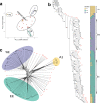Two distinct Fusarium graminearum populations colonized European wheat in the past two decades
- PMID: 38153926
- PMCID: PMC10754465
- DOI: 10.1371/journal.pone.0296302
Two distinct Fusarium graminearum populations colonized European wheat in the past two decades
Abstract
Fusarium graminearum is the main causal agent of Fusarium head blight (FHB) disease in wheat in Europe. To reveal population structure and to pinpoint genetic targets of selection we studied genomes of 96 strains of F. graminearum using population genomics. Bayesian and phylogenomic analyses indicated that the F. graminearum emergence in Europe could be linked to two independently evolving populations termed here as East European (EE) and West European (WE) population. The EE strains are primarily prevalent in Eastern Europe, but to a lesser extent also in western and southern areas. In contrast, the WE population appears to be endemic to Western Europe. Both populations evolved in response to population-specific selection forces, resulting in distinct localized adaptations that allowed them to migrate into their environmental niche. The detection of positive selection in genes with protein/zinc ion binding domains, transcription factors and in genes encoding proteins involved in transmembrane transport highlights their important role in driving evolutionary novelty that allow F. graminearum to increase adaptation to the host and/or environment. F. graminearum also maintained distinct sets of accessory genes showing population-specific conservation. Among them, genes involved in host invasion and virulence such as those encoding proteins with high homology to tannase/feruloyl esterase and genes encoding proteins with functions related to oxidation-reduction were mostly found in the WE population. Our findings shed light on genetic features related to microevolutionary divergence of F. graminearum and reveal relevant genes for further functional research aiming at better control of this pathogen.
Copyright: © 2023 Kulik et al. This is an open access article distributed under the terms of the Creative Commons Attribution License, which permits unrestricted use, distribution, and reproduction in any medium, provided the original author and source are credited.
Conflict of interest statement
The authors have declared that no competing interests exist.
Figures




Similar articles
-
Population genomics of Fusarium graminearum reveals signatures of divergent evolution within a major cereal pathogen.PLoS One. 2018 Mar 27;13(3):e0194616. doi: 10.1371/journal.pone.0194616. eCollection 2018. PLoS One. 2018. PMID: 29584736 Free PMC article.
-
The feruloyl esterase gene family of Fusarium graminearum is differentially regulated by aromatic compounds and hosts.Fungal Biol. 2012 Apr;116(4):478-88. doi: 10.1016/j.funbio.2012.01.007. Epub 2012 Feb 1. Fungal Biol. 2012. PMID: 22483046
-
Fusarium graminearum Infection Strategy in Wheat Involves a Highly Conserved Genetic Program That Controls the Expression of a Core Effectome.Int J Mol Sci. 2022 Feb 8;23(3):1914. doi: 10.3390/ijms23031914. Int J Mol Sci. 2022. PMID: 35163834 Free PMC article.
-
Transcriptomics of cereal-Fusarium graminearum interactions: what we have learned so far.Mol Plant Pathol. 2018 Mar;19(3):764-778. doi: 10.1111/mpp.12561. Epub 2017 Jun 7. Mol Plant Pathol. 2018. PMID: 28411402 Free PMC article. Review.
-
Recent advances on genome-wide association studies (GWAS) and genomic selection (GS); prospects for Fusarium head blight research in Durum wheat.Mol Biol Rep. 2023 Apr;50(4):3885-3901. doi: 10.1007/s11033-023-08309-4. Epub 2023 Feb 24. Mol Biol Rep. 2023. PMID: 36826681 Review.
Cited by
-
Fusarium graminearum in Wheat-Management Strategies in Central Europe.Pathogens. 2025 Mar 8;14(3):265. doi: 10.3390/pathogens14030265. Pathogens. 2025. PMID: 40137750 Free PMC article. Review.
-
Comparative analysis of distinct phenotyping methods for assessing wheat resistance and pathogen virulence among Fusarium species causing head blight disease.Plant Methods. 2025 Jun 16;21(1):85. doi: 10.1186/s13007-025-01402-8. Plant Methods. 2025. PMID: 40524223 Free PMC article.
References
-
- Desjardins AE. Fusarium Mycotoxins Chemistry, Genetics and Biology; American Phytopathological Society Press. 2006; St. Paul, MN, USA.

